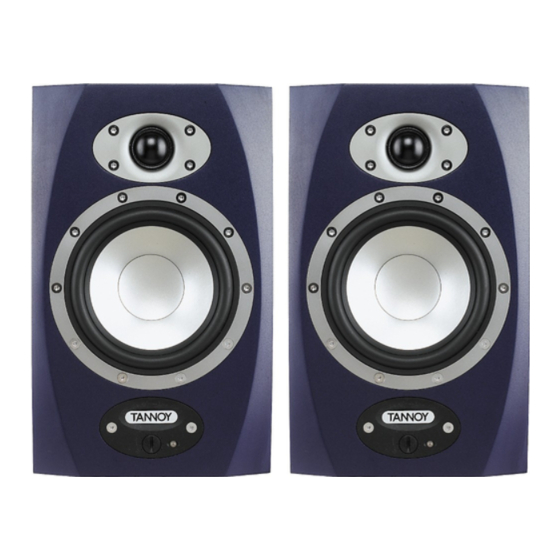
Advertisement
Advertisement
Table of Contents

Summary of Contents for Tannoy 6D 66D & 8D
-
Page 2: Warranty
1.0: IMPORTANT SAFETY INSTRUCTIONS 2.0: THE BASICS 3.0: REVEAL D SERIES FEATURES 4.0: EQUALISATION POSSIBILITIES 5.0: GUIDE TO SETTING THE EQUALISATION 6.0: PLACEMENT OF THE SPEAKERS 7.0: PERFORMANCE DATA 8.0: TECHNICAL SPECIFICATIONS 9.0: DIMENSIONS 10.0: SERVICING 11.0: WARRANTY 12.0: DECLARATION OF CONFORMITY 1.0: IMPORTANT SAFETY INSTRUCTIONS Introduction 1. -
Page 3: Installation
PC/Mac post production editing situations. The Tannoy Reveal Digital range of monitoring speakers can be optimised for far field, mid field and near/close field free space situations right through to far field, mid field and near/close field situations in difficult acoustic spaces such as meter bridge positions, adjacent to walls or reflecting surfaces and space restricted PC/Mac based sound editing environments. -
Page 4: Analog Input
Having chosen an appropriate location for your monitors and arranged them accordingly, connect the power cord to the mains socket and turn the power on. The LED on the front panel will now glow red. Push the Tannoy logo on the front panel to operate the switch to bring the amplifier out of standby mode and into operational mode. - Page 5 Low Mid Contour Frequency: A shelving filter can be set to the flat anechoic response or set to shelve at frequencies of 800Hz, 400Hz, or 200Hz in combination with the low mid contour amplitude (below) to correct half space (pi/2), quarter space (pi/4) and very difficult close field boundary conditions (pi/8 space).
- Page 6 Hi-Mid Shelf Boost/Cut: a shelving filter between 1kHz and 3KHz can be set to +2, +1dB, flat, -1dB, -2dB, to take account of room characteristics and personal preference. Editing news broadcast material is often easier with an increased output in this band.
- Page 7 Quarter Space (Pi): An example of quarter space would be with speakers mounted on stands in a corner, or on the meter bridge against a wall or mounted on small stands or shelves against a wall. Also typical PC/Mac editing in a confined space on a desk near a wall.
-
Page 8: Placement Of The Speakers
MID AND HIGH EQ SETTINGS RT60 Decay Time: An estimation of the RT60 decay time above 1kHz within the monitoring environment will help to set the mid and high frequency equalisation. Hard surfaces in general and particularly if close to the speakers will increase the amount of reverberent energy to direct energy above 1kHz (RT60 above 500mS) and may justify setting the mid or high EQ (or both) to -1dB. -
Page 9: Speaker Mounting
EQ, or leaning back and listening to the mix. Don’t go crazy trying to get this exact to three decimal places, within a few inches will suffice. Your Tannoy monitors have a wide sweet spot both horizontally and vertically to reduce the variations in sound quality as you move around doing your recording engineer stuff. -
Page 10: Performance Data
7.0: PERFORMANCE DATA R6D ON AXIS ANECHOIC FREQUENCY RESPONSE @ 1m R66D ON AXIS ANECHOIC FREQUENCY RESPONSE @ 1m R8D ON AXIS ANECHOIC FREQUENCY RESPONSE @ 1m... - Page 11 8.0: 9.0: ™ NOTES...
-
Page 12: Declaration Of Conformity
12.0: DECLARATION OF CONFORMITY The following apparatus is/are manufactured in China by Tannoy Ltd of Rosehall Industrial Estate, Coatbridge, Scotland, ML5 4TF. The following equipment is marked with the CE label and conform(s) to the protection requirements of the European Electromagnetic Compatibility Standards and Directives.
















Need help?
Do you have a question about the 6D 66D & 8D and is the answer not in the manual?
Questions and answers